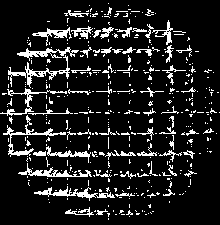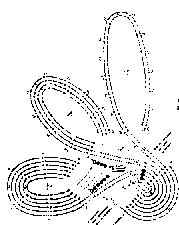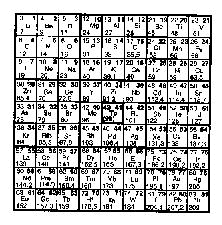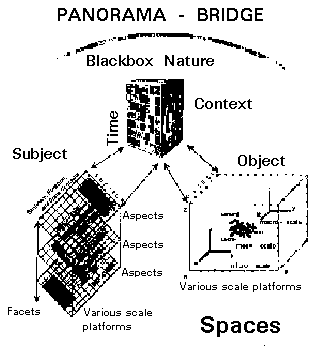| THE INTEGRITY PAPERS |
Genre - Benking - US Website |
ceptualinstitute.com |

Computation for
Metaphors, Analogy and Agents: An International Workshop
University of Aizu, Aizu-Wakamatsu City, Japan,
6-10 April 1998
Metaphors
Life-Like Agents
Imitation & Embodiment
Analogies
Heiner Benking
(University of Ulm, Germany)
Sharing and Changing Realities with Extra Degrees of Freedom of Movement
Sharing and Changing Realities
with Extra Degrees of Freedom of Movement
Heiner Benking
(1997)
"The only really new paradigm
would be to find the level of consciousness
where every known paradigm originates."
Georg
Kuehlewind
What
realities can be
First of
all, realities can be real or abstract, synthetic or imagined. The moment we embody
realities and are able to share them, they become real for us. The critical step is
accepting or resisting them, for their existence is unquestionable, as we realize form and
content, functions, positions, proportions and consequences. This article is designed to
bring such realities of Life and Society into awareness by plotting and editing them in
old forms and new, the combined and sharable spaces which we can call : situation or
problem-learning-solution spaces. It is important to accept, address and focus them,
instead of dismissing them as flat facsimiles or imaginary, not sharable, subjective
shadows. Such a merging, modifying and playing instead of fighting realities, as we do and
can not fight the ugly nightmare or dream of a child by trying to discuss it away with
words and hollow arguments.
What we are talking about here is mental
mobility, as the most natural and cheapest form of healing. We are talking about creating
and editing categories and boundaries, and bridging cultures, mind-sets and forms of
representations. Changing focus, subjects and objects of attention.
Additional degrees of freedom (mental mobility). How do we gain them?
- First, change the optic: lenses, views, pictures, perspectives,...
- Second, play with maps, models, paradigms and world-views (I would like
to call it Views of Life&Nature) and accept co-existent and coherent representations
(going beyond dualistic right or wrong and hierarchical orders as the only possible model)
- Third, change positions and integrate/orchestrate even incompatible
views, perspectives, and models.
- Finally, imagine and design a continuum or Navigation and Orientation
Space consisting of each three dimensions in three connected spaces - Cognitive Panorama
(3Space/Time).
1. Change the optic: lenses and perspectives
For any possible model there is an important potential of applying optical laws, since we
know that physical references hold equally as well for the abstract and conceptual
worlds. First the spaces have to be deep or nested three-dimensional, spaces we can
approach from different angles. We can pan and zoom to get to deeper levels or other
'planes'. As the integration of eyes, worms-eye, fish-eye, human's eye, bird's eye,
public eye and mind's eye has been covered elsewhere we can use the analogy of optics to
augment the human intellect and realise that the angles and perspectives, beside the way
we record our 'pictures', decide if we can create stereoscopic or even holographic models.
Seeing with new eyes and sharing our 'impressions' is definitely a new way to construct
'realities'.
It should be mentioned that reflecting on
representations reminds us that realities are cast quite differently and very
subjectively, sometimes seemingly unconnected and alien, forming totally different
opposing pictures - pictures which can cause totally different emotions, attitudes
we experience when looking at pictures taken from one object with different objectives or
wave-lengths.
TWO POSSIBLE VIEWS OF THE SAME OBJECT:
Complexity:
Transparency:
Hostile to any participation
Ready for
exchange and participation


Fig. 1: Positions
and Perspective, not only models, guide perception and create transparency or anxiety.
Morellet Sphere, Rive Gauche Gallery, Brussel, photo: A.J.N. Judge
Many further examples can be found in the study of body language. Poses and gestures are
seen and interpreted quite differently when seen other perspectives.
2. Change the maps, models, and paradigms
Central dilemmas include the lack of
global or wholistic pictures, and oversimplistic flat paradigms. No doubt,
reductionistic, materialistic and hierarchical approaches have their merits and help for
many processes, but they can be easily misused and cause much harm when combined with
overclaims used in applications beyond their scope and validity. Western Industrial
Society for example seems to be lost in fixation on hierarchical representations and
nominalism. Complexity and Ideas and Images are screened out and everything is put into
the straightjacket of monontone hierachical and unimaginate 'orders'.
Representations like paradigms
are given paths. We typically use them in one domain to have a guideline to achieve
something or go somewhere. The knowledge tree and bibliographic classification systems are
only one example of how we avoid complexity by moulding it into linear and sometimes
oversimplistic orders. Such representations support a simple and easy to remember
structure, especially if computers are used to handle large volumes of data.
Typically they are easy to understand and are
even practical when used inside their known (often not consciously reflected) boundaries
or limitations. It would be silly to blame a map, model or paradigm for being
wrong but it is our linear and dualistic education and View-of-Life, which makes us blame
others when it encourages us to cultivate oversimplifications and overclaims, instead of
paying attention to underlying rules, ranges and limitations.






Fig. 2: Alternative presentations of the periodic table or layout of chemical elements
The above is a selection of pictures from Functional Classification,
Appendix 4 pp.1763, Vol. 3 Yearbook of International Organisations as reproduced in part
from J.W. van Spronsen, The Periodic System of Chemical Elements, a history of the fist
100 years, Elsevier 1969, and the display, the 'Magic Square' form a recently conceived
and published design based on number theory as published in: Michael Stelzner, Die
Weltformel der Unsterblichkeit " Vom Sinn der Zahlen " Die Einheit von
Naturwissenschaft und Religion VAP Wiesbaden, 1996, ISBN 3-922367-70-4. In chapter 3: The
Third Dimension, p 369-370.
The last model, the 'magic
square' matrix, is not typically known, or 'accepted', it might be even called
arbitrary by some scholars. Nevertheless, this new design is highlighted here to show that
there is an ongoing search for new models which are simple and complete and
insightful! AND which make sense for certain, given purposes or quests for
knowledge, open to being amended, improved or even discarded by further developments or
insights, earning acceptance in some eyes .. one day.
All these displays are arbitrary and have
their own validity and perspective/purpose, being coherent and fulfilling of those
purposes. They show the extent of knowledge, perspective or detail
called for at a given time, and in given frames, display a true picture according to the
objectives or course of discovery of what we know or how we master the art of mapping and
modeling of Nature. Most of the stages in finding a model of reality were faithful
and helped us to ask new questions and see new connections, in retrospect is the
epistemology of what and how we know something, even if we can not always appreciate in
the moment what is most exciting or revealing or important.
The matrix or a
three-dimension scaffolding can hold many different schema or orders. The work of Anthony
Judge and I. Dahlberg are covered to great depth in other publications, so we invite you
to visit the site of the authors and go to 'source' the original works (see in particular http://www.uia.org/webints/aaintmat.htm
and the overview and historical orientation article 'Functional Classification' by A. J. N.
Judge). These backgrounds indicate that we can design or construct deeper
logical and coherent orders. The agreement on such anticipatory schema to map items allows
us to switch between schemata and gives rise to much hope for bridging cultural
repositories and making available sources which now are hard to locate and access. This
gives much hope for further projects in the field of archiving and cultural
navigation. See in particular: Veltmann, K.H.: Frontiers in Conceptual Navigation,
ISKO Conference on multimedia applications, to appear in 'Knowledge Organization' early
1998.
3. Change positions and purpose to
relate/integrate/orchestrate
'incompatible'views, perspectives, and models.
The integration of such different views of
reality or nature is seen as an important step towards tolerance. It is simplistic
to make us aware that we only see different pictures of a reality, like entering a village
from different directions or looking from above or just out of a certain window or door
(frame). To create a complete framework of views, bridging all the scales,
perspectives and intentions under which pictures were recorded, will never be possible.
Yet it is possible through education and experience to create a picture of the
whole, keeping in mind the resolution and purpose of the 'frame-construction', and the
open willingness to question the construction, since different time or wave-lengths or
-widths might lead to different models and re-imaginations.
As there seems to be some
misconception about maps or matrixes (some considered widely authoritative or final),
we will show below -- or give reference to -- approaches to order and see in one
image a coherent layout of indexes of data or knowledge under a given perspective. The
difference between any scaffolding, matrix or layout to the following two classification
schemes can be assessed by the following criteria:
1) Is the layout simple, easy to remember, logical, coherent and complete?,
or,
2) is it
far from any organized higher order only a mess or chaos of data?
Figure 4 is a matrix proposed
15 years ago for providing an index for knowledge ideally suited for library access, even
in different languages, allowing to switch between or link other classification schemes.
Figure 4 is a system conceived to keep the inner and higher order as far as possible in
mind, but compromising for the sake of specific applications and purposes.
Functional Classification, Figure 3b was developed to index and update large volumes
of data from International Organizations. We refer you to example literature like the
overview articles of A.J.N. Judge on Functional Classification, and the work of this
author in multilingual, meta-databases, terminology and harmonization projects: link
<**>. Please note that other representations, besides the well established
hierarchical tree-structures, are readily available and feasible for data storage and
retrieval, notably in multilingual, multi-cultural, and interdisciplinary areas of
applications.
A Universal Ordering System
An Integrative Matrix
for Disciplines and
Phenomena
of Human Preoccupations
| |
Matrix columns |
Matrix levels |
|
Matrix columns |
Matrix levels |
|
|
9 |
Culture |
Distribution and Synthesis |
|
9 |
Condition of the whole |
Experiential (modes of awareness) |
|
|
8 |
Science & Information |
Application and Determination |
|
8 |
Environmental manipulation |
Experiential values |
|
|
7 |
Economic & Technology |
Technology and Production |
|
7 |
Resource redistribution |
Innovative change (context strategies) |
|
|
6 |
Socio |
Institution or Content |
|
6 |
Communication reinforcement |
Innovative change (structure) |
|
|
5 |
Human |
Persons or Content |
|
5 |
Controlled movement |
Concept formation (context) |
|
|
4 |
Bio |
Property Attribute |
|
4 |
Contextual renewal |
Concept formation (structure) |
|
|
3 |
Cosmo & Geo |
Activity, Process |
|
3 |
Differentiated order |
Social action (context) |
|
|
2 |
Energy & Matter |
Object, Component |
|
2 |
Organized relations |
Social action (structure) |
|
|
1 |
Form & Structure |
Theories, Principles |
|
1 |
Domain definition |
Biosphere |
|
|
0 |
Subject Areas |
General Form Concepts |
|
0 |
Formal pre-conditions |
Cosmosphere/Geosphere |
Fig. 3a
Fig. 3b
Information Coding Classification
Functional Classification
I. Dahlberg (c)
A.Judge
The above are only two from
many possible ways to structure knowledge in a coherent and meaningful way. It is
important to realize that many further matrixes or maps are possible and feasible. What we
learn from these exercises into ways of structuring information is, that 1.) we have
to look for coherent, transparent, simple and easy to remember layouts, 2.) they
solve real needs, get applied and make data available, 3.) they create, logical unique
locations for entries for the sake of reducing the volume of redundant information, and
4.) they help people to understand connections, make sense, and see the whole.
It is important to understand
that 1.) regarding depth of information, a coding up to 5 or more digits helps to
structure with a much finer 'granularity', that 2.) ontologically- based general concept
systems allow to implement a 'Systematifier' principle (Dahlberg), what Judge calls a
'Structural Outliner', that 3.) such systems can be implemented as 'switching systems'
which enable re-coding and translation between other, typically hierarchical and
proprietary classification schemes, which are typically found in different libraries, and
4.) that there is a possibility to use such schemata as the backbone for multi-lingual
information and classification systems, as languages can be considered to be just another
'level' (see more about this in Figure 5). All these features can help build
conceptual bridges in order to roughly identify something in other cultures and languages,
enabling translation, when appropriate.
The first matrix, the ICC,
was developed for library sciences and has another unique quality: inner or higher order.
The second matrix (FC) is more of an experimental nature, subject to changes, as
application and production requirements suggest. When looking closer, we see that the
realm of the second matrix is much wider, but both like many possible others, have their
purposes and find their place.
We show the partial detail
these two scaffoldings to make aware the potential for outlining themes in a holistical or
complete and coherent sense. This is a compromise but it has distinct advantages over the
traditional hierarchical 'knowledge-tree' structure because they provide knowledge-spaces,
which can be outlined, visualized, and embodied. Behind this is a quite different
handling of words, taking words into space as the Australian Linguist proposes or as the
father of holism, Jan C. Smuts has proposed by considering and manipulating words like
fields in space.
For more, see ISSS Primer WHOLENESS Seminar: http://www.newciv.org/ISSS_Primer/asem09js.html
Area/
Form/
Concept |
theories, principles |
object, component |
activity, process |
property, attribute |
persons or content |
institutions or content |
technology & production |
application & determin-
ation |
distribution
&
synthesis |
| form & structure |
11 logic |
|
|
|
|
|
|
|
|
| energy & matter |
|
|
|
|
|
|
|
|
|
| cosmo & geo |
|
|
33 geo-
sciences |
|
|
|
37 mining |
|
|
| bio |
|
|
|
|
|
|
|
|
49 ecology & environ. |
| human |
|
|
|
|
|
56 education |
|
|
|
| socio |
61 sociology |
|
|
|
|
66 law |
|
|
|
| economics & technology |
|
|
|
|
|
|
|
|
|
| science and information |
|
82
information sciences |
|
|
|
|
|
|
89
semiotics |
| culture |
|
|
|
94
fine arts |
|
|
97 philos. |
|
|
Fig. 4: A matrix
organisation of subject fields called the ICC, Information Coding Classification system.
A survey of subject groups or a new universal ordering system for
disciplines and phenomena. The schemata conveys not only the sense that a holistic
organization is possible - with broad categories in which to organize and relate diverse
integrated systems - but that given sub-systems can be members of several cross referenced
categories (as described in vernacular in J N 's "Understanding
the Integral Universe"- Introduction (1992)).
Please note, we do not
show the content of each cell, or how they are coded, merely samples given. You can
find more about this grid and about ongoing research projects in this field here [ webmaster note:
link temporarily inactive]. More importantly, this scheme is
there to help you look for yourself, ask new questions and find new structures and
relations, which is essential for creativity. For the purpose of this paper we
only show that we can tune our thinking to look for coherence and connectedness. This is
mandatory in order to avoid the redundancies we are confronted with today -- in an era of
confusion and overload of messages with dubious value.
I see such a grid as
one possible way of making sense for a given purpose or certain aspect, then we can show
connections and identify not only a cell, but columns or area consisting of a couple of
small parcels of 'land'. In this way we can outline and search for subjects and
issues more coherently! We will find out that some cells have relations with only few or,
as in the case of the term ecology for example, we could define relations with nearly
every other cell and can in this way detail it in a meaningful way. The following
are only some examples in the broader 'area 49' of ecology and environment: 4951:348 air
pollution, 4925:428 marine microbiology, 4938 garden and parks architecture,....
4. A Navigation
and Orientation Space
Finally, a Navigation and Orientation Space to embody
Situations consisting of each of the three dimensions in three connected spaces: This can
be understood as the Japanese bio-holistic 'ba' concept for inter-spaces. There is a need
to index and find real and conceptual entities and to find ways to present such in
coherent layouts.

Fig. 5: The Cognitive Panorama, in its
limitations, is one of many possible candidates. There is also a need for the coexistence
of different forms of representation and an easy transformation and translation between
the different models, foci, and forms. By combining and overlaying such representations
annotations new connections and insight might come up and canyons between objects and
subjects will be bridged. see details about the Cognitive Panorama Bridge at
http://newciv.org/cob/members/benking/benking.html
and http://www.newciv.org/ISSS_Primer/asem09js.html
There is a definite need for
simple, coherent and open models acting as common frames of reference, in order to
accommodate diverse perspectives and teach tolerance, coherence and harmony. In particular
the Western Societies, seem to be fixed or blocked in their way of seeing the world. They
neglect the issue of the need for models to aid our thinking and sharing references.
Instead modern societies opt for having no model or WORLD -VIEW at all! As
this is the result of 30 years of education into 'Subjectivity', every thing is seen as
relative and vague. We should not wonder that this resulted in the cultivation of
'self-esteem' and ego-develoment, instead of building society on confident children having
and changing directions and orientations.
One final remark is in
order. In the "Cartographer of Consciousness" by Brian Van Der Horst,
.."Ron Siegel probes the hallucinating brain to chart hidden features of our mental
landscape" Omni, Sept. 1980, the author uses Heinrich "Kluver" to
present a geometric recursion. There is much research going on in this field (which will
be covered elsewhere). For this little journey along maps and representations it can at
least give us the idea of connectedness of physical and mental realms. The only problem is
our problem of believing in one 'authoritative' map or matrix, the one and only school or
'dogma'. The presentation of the chemical elements proved that there are many views and
schemata possible and even they all together are just maps, not the territory, as Alfred
Korzybski wrote.

Fig.6: Form constants as mapped by the 'cartographer of
consciousness'
Final musing:
The central problem of our Society is our ruling one-dimensionality (duality) of our
thinking and acting and the apathy or aggression resulting from feeling 'lost in space'
instead of resorting to our original capabilities of path-finding, bridge-building and
barriers-editing.... As we do not question representations and look behind words
(nominalistic instead of conceptualistic thinking) we do not switch codes, translate or
transform meanings. We are fixed into one perspective, instead of looking into sharing and
questioning. Only when we dare to tell and show our Children, that 1.) we also
do not know and that there are things which are 'unknowable', when we 2.) take them by our
hands and explore with them the INTER-SPACES, the terrain in-between the pictures or
landscapes (ceptualinstitute.com/genre/benking/landscape.htm),
and when we 3.) jump and edit 'fences' and explore new levels, we will reach new shores of
social and ecological consciousness by bridging meaning,sharing understanding, in what we
called a meta-paradigm, a framework of being and sharing. http://newciv.org/cob/members/benking/benking.html.
Acknowledgements: It is clear that without the work of Dahlberg, Judge and
Veltman this work and progress from harmonization of environmental information, to
meta-databases, education and and policy making would not have been possible. As there is
a strong relation and much material is used, in particular from Judge, the question of
integrating and providing a collage of the work of others is the right thing to do. The
author felt it is not only important to link and make known this work but combine it and
and create through the 'umbrella' of the panorama something new, maybe a step towards more
synthesis and synoptics.
The work of Mrs Dahlberg is only available through ISKO and its publishing house INDEKS,
Frankfurt and the Journal Knowledge Organization - KO. For visitors the author can
recommend not the introductionary article of Anthony Judge on Functional Classification and the work
of Kim Veltman from the Perspective Unit of the
McLuhan Institute in Toronto.
END
Whoever imagines mental barriers which actually do not
exist
and then thinks them away, has understood the world.
As space is entrapped in geometry's network of lines,
thought is caught in its (own) inherent laws.
Maps make the world comprehensible to us;
we are still waiting for the star-maps of the spirit.
In the same way that ambling through fields
we risk getting lost, the spirit negotiates its terrain.
Friedrich
Rückert , "Wisdom of the Brahmins"

Links
| Integrity /
Ceptual Institute Homepage |










